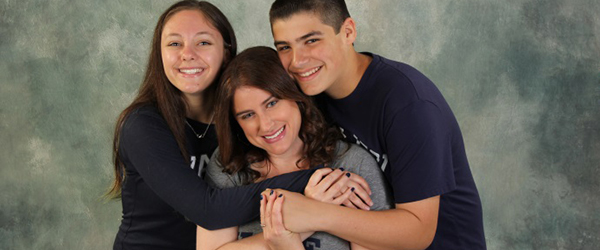
By Shari Bender
Mother of two kids, Joe, age 14, and Rose, age 18, who has hemophilia A
The ideas expressed in this article are the author’s opinion and should not be, in any way, taken as medical advice. You should consult your own doctor if you need any specific advice about treating your bleeding disorder.
I gained 60 pounds with my first pregnancy. Steaks, whole milk and ice cream were my new BFFs and on May 15, 1997, I gave birth to a beautiful 8lb 1oz perfect baby girl named Rose.
If I had only known the post-pregnancy pounds were the least of my worries.
My whole world was turned upside down when I was told that Rose, at the tender age of 9 months, may not make it through the night. Fresh-frozen plasma, cryoprecipitate and whole blood were needed to save my baby’s life.
Hemophilia was making its grand entrance into our lives.
It was a whirlwind of doctors and incorrect diagnoses before we got the correct diagnosis: Rose had severe hemophilia A, <1% factor. No family history. How did this happen to us? There was little time for self-pity (although somehow I managed to squeeze it in, collapsing in my own heap of tears from time to time) and the race was on to learn as much as possible, and get the support and care Rose, and we as a family, needed.
ABCs and Factors 1, 2, 3
Infusions became a frequent event. Rose would bump her head, have a knee bleed or a playground mishap and we would have to hold her down while a nurse often struggled to do the infusion. It’s hard to have a conversation about hemophilia with your screaming baby, but we blew bubbles to distract her and told her everything would be ok. How to create positive associations with seemingly all-negative and painful infusions? I spoke to Rose in a comforting voice, telling her that the infusion would help her bleeding and keep her healthy. When she started preschool we talked more about hemophilia and even learned how to spell it.
You wouldn’t believe how many people cannot spell "hemophilia."
Include your child in filling out the hemophilia log, let him/her draw pictures or make up names for new veins and even names for bruises (my favorite “Bruce, the Bruise”). As he or she gets older let your child choose if they feel comfortable sharing their disorder with their class, as hemophilia is often included in science curriculums, even in elementary school. Participating with your child in your local Hemophilia Walk, from baby stroller to high school senior is a great way to start the conversation about bleeding disorders. The more often you talk about hemophilia and integrate it into your life, the more comfortable your child will feel. Even Bruce the Bruise would agree with that.
Be safe, have fun,
Shari
Shari Bender has served on numerous National Hemophilia Foundation committees, including First Step for new families and Victory for Women. She co-founded the New York City Hemophilia Chapter and served as its first president. Shari and her husband Stephen remain active and helped raise more than $1.5 million to support the bleeding disorders community. This article is part of a 10-part series Shari is currently writing, "Parenting Tips to Help Raise a Happy, Healthy, and Successful Child with a Bleeding Disorder." Subscribe to NHF Notes to follow this 10-part series.





